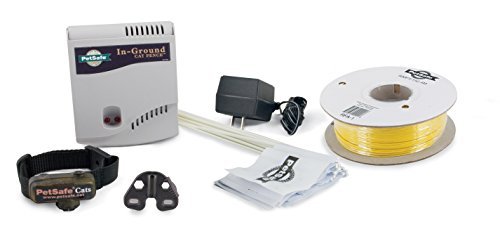Losing your beloved furball is one of the worst things for any pet parent out there. Even if you’re keeping your feline friend strictly indoors, there’s no guarantee it won’t accidentally end up outside.
But things are even more complicated for pet parents who allow their kitties to roam the outdoors.
Why would a cat want to leave the safety of your yard or your loving home?
- Curiosity about scents, sights, and sounds
- Heat cycles
- Fear, anxiety, or other emotional distress
A cat’s inborn curiosity, hunting instincts, whimsical mood swings, and adventurous side can send it off exploring. Of course, kitties don’t consider the possible consequences of such impromptu adventures.
Road accidents are probably among the first things that come to mind when considering outdoor disasters. However, even if your house or apartment isn’t located on a street with busy traffic, that doesn’t mean your pet will be safe if it escapes your home.
Many people use invisible fences.

What Are Invisible Pet Fences And What Do They Do?
The way invisible fences work is quite simple. An invisible fence is basically a combination of two or more devices – transmitters and receivers. The transmitters can be placed indoors or outdoors, outlining a safety zone or creating an invisible threshold. When the boundaries are crossed, the transmitter emits a wireless alert signal to the receiver.
The receiver is located inside a collar.
When your pet tries to cross the invisible boundaries set by the transmitter, motion sensors are triggered. Then, the receiver inside the collar will act upon the warning settings you’ve selected. There are three types of warnings:
- Electric current (shock)
- Sound
- Vibration
As such, whenever your cat attempts to cross the line, it will either be warded off by an electric current, a sound, or a vibration.
Will It Work On Your Cat?
Depending on your cat’s temperament, the results will be different. Invisible fences can indeed scare any cat away from the idea of crossing any boundaries. Unfortunately, they may also inflict emotional trauma on your pet. They might cause anger, stress, anxiety, or other kinds of harm.
What’s more, they also hurt the cat physically.
If possible, I would always recommend building an actual fence rather than using an invisible cat fence.

Cats have extremely heightened senses. The electric current in invisible fencing systems isn’t that strong, but it’s still painful. If your pet has a problematic heart condition, invisible fences for cats or dogs must be off-limits! And even if your kitty is healthy, the sound and vibration warnings will still be too overwhelming for its senses.
So, yes, invisible fences do work on cats. But should you use them? I’m personally not a fan of any type of shock collars when it comes to using them on felines. The Humane Society regards even dog collars as “the least humane” form of training device. And a canine can withstand higher voltage than a feline.
Review Of The Best Invisible Fence For Cats
If you feel like you must use an invisible fence for your cat, there’s one choice we recommend. But it is a hit or miss deal as it will depend on how your cat responds to sound.
Don’t ever shop for shock collars as training devices, and don’t do it at your corner pet store! Those over-priced, good-for-nothing products often transmit inappropriately high voltage. Moreover, you probably won’t be able to find receivers suitable for cats in such stores. Trying to use a regular shock collar manufactured for dog training can easily injure your pet!
Our review process is unbiased and based on extensive research. If you buy through the links on our site, we may earn a commission.
PetSafe offers a plethora of cat supplies that are not only safety regulated but also durable, which is why I like this brand so much.
They offer an in-ground kit for invisible fencing for cats, which is more efficient than wireless pet fences. It comes with a set of flags as visible indicators of the confinement zone.
Why is this option humane? Because you can set it to use only sound warnings instead of electric current.
Do not use the shock feature!!! I also don’t recommend leaving the receiver (collar) on your cat’s neck for longer than a few hours. The collar isn’t that heavy, but your pet will be more comfortable without it when it’s indoors.
>> Tap Here To Read More Reviews and Get The Best Price On Amazon <<
Regardless of the low voltage, positive reinforcement training practices are much more humane for setting indoor boundaries than any shock collar. I wouldn’t recommend using the shock feature on any invisible fencing system at all.
Electric shocks can harm your pet on a mental and physical level. So, it’s not only cruel but also pointless to use shock training. After all, you’re getting a fencing kit for your pet’s safety and well-being, right?



Hi Emily,
I read your article on wireless electric shock fences for cats. My 2 cats tear up and pee on my furniture in the living room. A wireless fence would be perfect. There are 2 types of wireless fences. One with a physical wire that triggers a shock when the collar comes close to the wire of the fence. The other has no wire but triggers a shock when the collar comes in proximity to the controller. Which do you recommend for a living room?
Hi David – Usually a wireless one is best for this, because the wire is supposed to be dug underground. Even if it’s not, you usually staple it to your lawn so it’s out of the way. You may be able to do that in your house, but it’s less likely, and the wires might be too long anyway. Hope that helps!